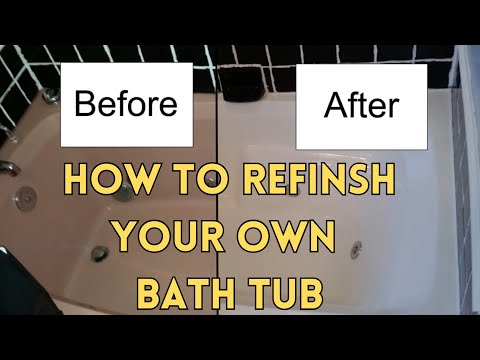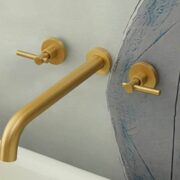When you’re remodeling a bathroom, you’re probably thinking of replacing your old bathtub. However, when you add all the other factors, you might change your thoughts and opt to refinish a bathtub.
For instance, a new tub significantly increases the total bathroom remodel costs. A simple 5-foot enameled steel tub might cost less than $150, but when you add the cost of a contractor, removal, demolition, landfill fees, and a plumber, the total cost of the job shoots up.
Similarly, relining a tub with an acrylic liner is costly, and it merely fixes the problem. The prices equal to or sometimes even greater than refinishing. Bathtub liners are not even an option.
Refinishing a bathtub is always cheaper when compared to a full replacement, and unlike refinishing, you never worry about the finish wearing away.
Why Should You Refinish?
The best thing about refinishing a tub is that your bathtub stays in the same place. With bathroom remodeling, when you change the bathroom layout, you have to consider tens of other factors.
It is a chain reaction, so it stands to reason that if you can keep your bathtub in place in order to refinish it. Similarly, you won’t experience this terrible, disorganized, cascading effect of tile surround, cement board, flooring, and moving plumbing fixtures.
When you have professionals refinish your tub or recoat the tub yourself, all the work is done on-site. Further, surrounding materials include tile, flooring, and all the other elements that are masked off and left in place.
The Average Cost to Refinish a Bathtub

Replacing an old bathtub with a newer model is not an easy task for most homeowners. The original tub always needs to be cut into pieces to fit through the bathroom door.
Further, there might be flooring, trim, surrounds, and plumbing that you need to remove and replace. Although a new tub can cost as little as $150, labor charges for the replacement process can easily add up to $2,000 or more to the bill.
Therefore, many homeowners have their existing tub regularly or refinished, which typically costs anywhere between $300 to $600 depending on the area and process.
If your bathtub is soiled and stained, or even if it has some serious cracks, a bathroom remodeling contractor can easily fix and recoat the surface to look like new.
Professional Bathtub Refinishing Process
Professional bathtub refinishers usually call their process reglazing, and the specific steps they use may somewhat differ. But the basic process is overall the same or standard.
Furthermore, cast-iron, steel, and fiberglass tubs and shower stalls can all be recoated to match the original finish or in a completely new color.
The bathtub refinishing process usually involves three steps:
- First of all, the technician strips off the old finish and sands out the tub to create a smooth finish.
- Next, they repair any cracks, holes, chips, or rust spots.
- Finally, they apply a primer, multiple layers of coating, and a sealant.
The bathtub usually becomes usable in a day or two, and the finish lasts approximately 10 to 15 years, making it a value-for-money choice.
How to Refinish a Bathtub?

This work is usually best if left to a trained professional, but certain DIY bathtub refinishing kits are available at many home improvement stores if you want to DIY.
However, it is essential to note that these products don’t use the same technology as the professionals, and you can end up making some serious bathroom remodeling mistakes.
But if you plan to refinish your bathtub yourself, make sure the area has proper ventilation before you begin the bathroom remodeling process. Moreover, open all bathroom doors and windows, and turn on the ventilation fans to help air out of the room. Next, put on your safety goggles and gloves and follow these DIY bathtub refinishing steps.
Bathtub Refinishing Steps
- Firstly, repair any chips or cracks with any heavy-duty patching compound (usually available at $6). After that, let the product fix entirely before you continue.
- Now, remove faucets, metal drains, and hardware as and when needed.
- You will now have to clean the bathtub with a bleach and water solution thoroughly. Then rinse the tub.
- Remove all the caulk and wipe the area until dry.
- Now, sand the tub to roughen the surface. That will help the coating to stick. After that, rinse the tub to remove dust.
- Dry the tub with a cloth. When the surface is arid, wipe the bathtub with a dry tack cloth to remove any remaining dust.
- Lay down a drop cloth and strip off the area surrounding the trub and any other remaining hardware as well.
- After ensuring proper ventilation in the bathroom, follow the instruction manual (supplied by the manufacturer) for applying the paint. Try to use a high-quality, short nap roller for the main areas and touch up corners and other hard-to-reach spots with a small foam brush.
- While waiting for sufficient drying time between coats, apply coats as and when needed.
- Once the coating is dry, remove the tape, reattach hardware, and caulk around the tub.
- Let the coating dry completely before using your bathtub.
After DIY bathtub refinishing, it would be best to avoid using any abrasive cleaners to protect the surface.
When Should You Do It?
Refinishing is well-suited to very old bathtubs that have more character and are made up of higher-quality materials. Of course, the process is not always the best solution while remodeling your bathroom.
For instance, you will definitely get better results for a newer or low-quality tub by replacing it with a high-end model.
Furthermore, if you are remodeling your bathroom and want a larger bathtub or one with more features, you will need to demolish and replace the bathroom rather than refinishing it.












